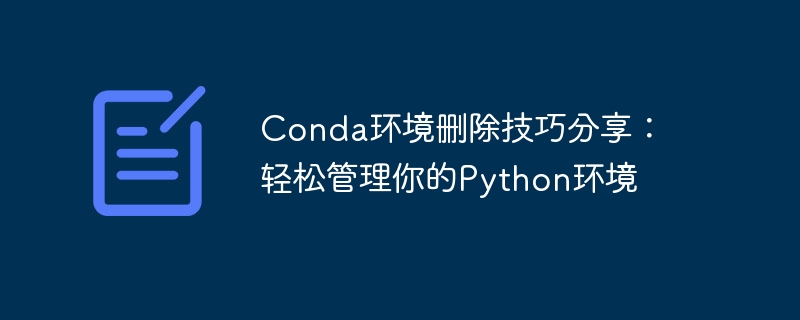

Conda environment deletion tips sharing: Easily manage your Python environment
If you are a Python developer, you may encounter the need to manage multiple Python environments at the same time Case. For example, you may need to develop using both Python 2.7 and Python 3.x versions while maintaining a project, or you may need to switch different Python environments between different projects. Using the Conda environment management tool provided by Anaconda, you can easily create, install, update, and delete multiple independent Python environments. In this article, I will share some Conda environment deletion tips to help you better manage your Python environment.
First, let’s take a look at how to use Conda to create a new Python environment. Suppose we want to create an environment named "myenv", run the following command:
conda create -n myenv python=3.8
The above command will create a new environment named "myenv" and install Python 3.8 version. Next, we can activate this environment using the following command:
conda activate myenv
Now, we can install the required Python packages in the "myenv" environment, and these packages will not affect packages in other environments. When we finish a project, we can free up disk space and resources by deleting the environment.
To delete a Conda environment, we can use the following command:
conda remove -n myenv --all
The above command will delete the environment named "myenv" and all packages related to the environment. This ensures that we completely clean up the Python environment that is no longer needed.
However, sometimes you may only want to delete a certain package in an environment, rather than the entire environment. Next, I'll cover how to delete individual packages in an environment.
To delete a package in an environment, we first need to activate the environment. Activate the environment named "myenv" using the following command:
conda activate myenv
Next, run the following command to remove a certain package, such as "numpy":
conda remove numpy
The above command will remove a package from "myenv" The "numpy" package is deleted from the environment, but does not affect other environments or the global Python environment. This is useful for managing dependencies within a single environment.
In addition to removing environments or packages, Conda also provides some other useful commands and options to help you better manage your Python environment.
First, you can use the following command to list all environments:
conda env list
The above command will list all environments that have been created and display the currently activated environment.
You can also use the following command to copy an environment, which is very useful when creating a similar environment or a backup environment:
conda create --clone myenv --name myenv_copy
The above command will create an environment named "myenv_copy" and Copy all packages from the "myenv" environment to the new environment.
In addition, you can use the following commands to export and import the configuration of an environment to facilitate sharing environment configuration information on different machines or operating systems:
conda env export > environment.yml conda env create -f environment.yml
The above command will export the configuration of the current environment. into a YAML file and use that file to create the same environment on other machines or operating systems.
In summary, during the development process using Python, using Conda to manage the Python environment can help us better manage the project's dependencies and easily switch between different Python environments. This article shares some Conda environment deletion tips to help you better manage your Python environment. Whether removing an entire environment or individual packages, Conda provides simple yet powerful commands to meet your needs. I hope these tips will be helpful to your Python development work!
The above is the detailed content of Simple management of Python environment: Master Conda environment deletion skills. For more information, please follow other related articles on the PHP Chinese website!




